Volleyball drills for technique passing / defense / reception
Focus of this exercise is the service pass.
Start serving calmly, raise pressure in the course of the exercise.
- A serves to B
- B passes to C
- C catches, and joins position D
- D serves or E
- E passes to F
- F catches and joins position A
Expansions:
- A takes 3 steps into the field, after the pass/set up follows a controlled straight attack, which A defends himself .
- A catches ball, and gives it to a reserve server on position A
- Idem for D
8 Players: reserve on serving position
10 players: position reserve on serving position and pass
12 players: 2 reserves serving position, 1 reserve pass position
14 players: 2 reserves on serving position and pass
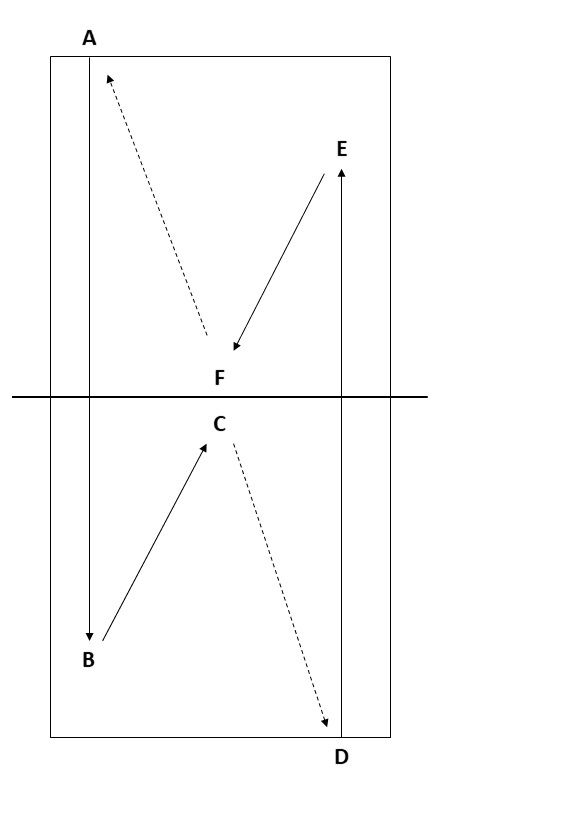
These exercises are done in pairs
- Exercise 1:
- Person 1 is at the net with a ball,
- person 2 starts at the 3-meter line.
- Person 1 hits the ball and person has to run back and play the ball back to person 1.
- 10x per person.
- Exercise 2:
- Person 1 is on the 3-meter line with a ball.
- Person 2 is going to block at the net, and then turn around to play the short ball by person 1.
- 10x per person.
- Team of both sides field end line.
- enter the field in pairs.
- Trainer brings ball into the field and pairs have to try underhand to score with the other pair
- Winning the pair remains and lost pair joins the back of the line.
- Team with the least balls on the ground wins.
- quintet with 1 ball. 1 player is at the net
- Opposite him/her is a trio next to each other
- If the ball thrower throws a ball to the middle, the middle player passes the ball back and everybody remains.
- If the ball is thrown left, the player passes the ball back and changes left for mid
- If the ball is thrown right, the player passes the ball back and changes right for mid
Which trio keeps this up the longest.
If a ball is missed, the player that made the mistake leaves the field, and a new player comes in the middle.
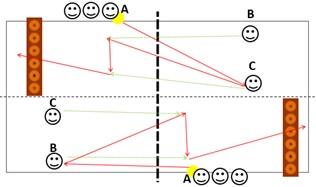
- Player A throws the ball over the net.
- Player B or C passes the ball over the net.
- The other player quickly runs underneath the net, and sets up for the same player that passed.
- This player tries to hit a cone from the bench with overarm player or a hitting movement.
Which pair or which team has hit the most cones from the bench after an X number of minutes?
To make sure that players learn to play in a rhythm, the ball has to be under way for 2 seconds each time (21-22).
- All players will try to play synchronously at the same time.
- This starts with overarm.
- The next form is that the player in the back field is going to play underhand and the player on the net overarm.
- In this way it can be extended.
he most important thing is that the players keep the ball in the air for 2 counts.
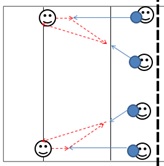
See picture. Each trio 2 balls. 2 players at the net number of meters from each other, other player in the back field.
- Exercise 1: Players rapidly throw in turns, player in the back field returns ball underhand.
- First ball is deep, 2nd ball is short
- Exercise 3: Throwers increase their distance apart and throw straight: player with ball at the side line throws deep, other short .
Change places after x number of balls or after a certain time.
Hit to outside and middle
Daarna
Beside the playmaker, the other players execute a pass, an attack, and a service.
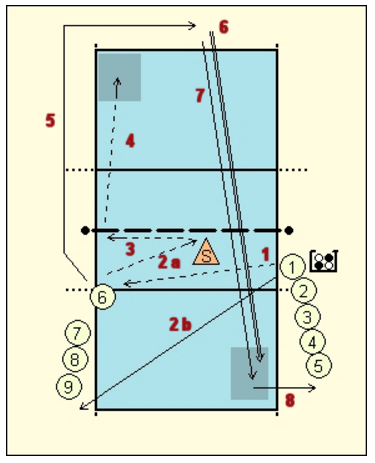
The exercise is as follows:
- 1 Player 1 throws a tight ball to player 7
- 2a player 7 passes the ball to the playmaker
- 2b player 1 walks to the other line and joins the back.
- 3 the playmaker gives a set up to player 6
- 4 player 6 smashes the ball to the mat
- 5 player 6 picks up his own ball
- 6 player 6 serves the ball to the other mat
- 7 player 6 picks up his own ball
- 8 player 6 joins the line
- This can also be done a middle attack
After 10 minutes, a block is added
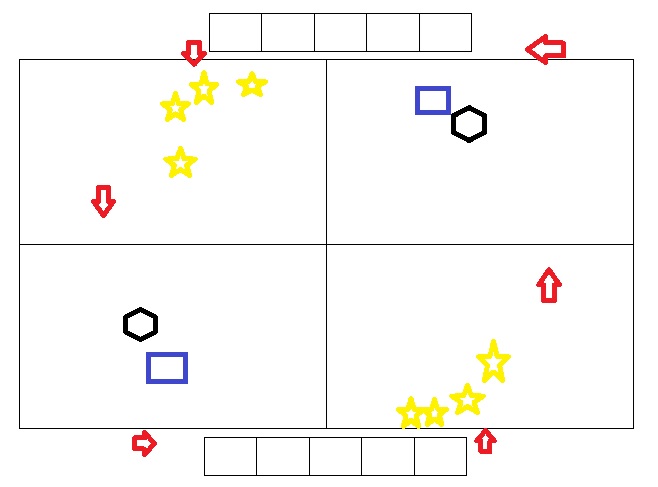
Basic exercise:
- Trainer throws the ball, player catches the ball and puts it in the cart.
- Then the player goes to the ladder, goes through it, and joins the next line.
Differentiation/Expansion:
- Throw difficult balls (left and right, front and back).
- Play underhand for themselves and catch.
- Two players get ready next to each other and have to call let go.
- A setupper is added who has to catch the underhand ball.
- An attacker is added who has to play the setupper's ball over the net.
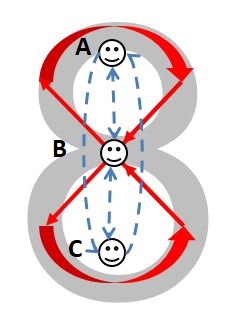
- Make trios
- Each trio has a ball.
- Player in the middle keeps running an 8. Every time this player comes in the middle, a ball is thrown:
- A throws (or plays overarm) the ball to B (in the middle)
- B throws the ball underhand back to A and then runs around A until he is back in the middle.
- Meanwhile, A plays the ball to C
- C returns the ball overarm to B.
- B plays the ball underhand back to C and then runs around C until he is back in the middle.
- Enz.
- after 2-3 minutes the player in the middle is changed.
Variation:
- To make it simpler, player A and C can throw instead of playing overarm. Could be underhand throwing/catching or overarm throwing/catching.
- To practice standing still when playing/throwing, player B can throw and catch underhand.
- The team is divided in 2 groups.
- Place a group on both sides of the net.
- 1 side will serve, the other side positions 3 passers
- They try to pass the ball high and this has to be caught on their own side.
- Servers take turns.
- A new passer will enter the field to replace the one who has caught the ball.
2 They play until 10 points. The servers score a point if the ball is not caught. The passers get a point if it is caught. Incorrect service does not count. After a round, they switch sides.deround with 2 passers instead of 3.
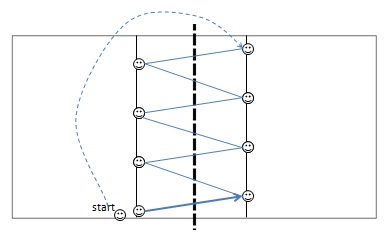
Divide over 3m line. Throw ball in zig-zag pattern and follow. See picture.
Later, play underhand, only overarm. One side of the net underhand, other side overarm.








